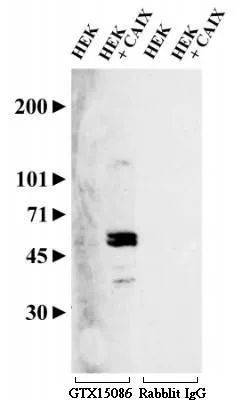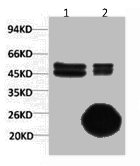Carbonic Anhydrase IX antibody [HL1410]
GTX636876
ApplicationsImmunoFluorescence, Western Blot, ImmunoCytoChemistry, ImmunoHistoChemistry, ImmunoHistoChemistry Paraffin
Product group Antibodies
TargetCA9
Overview
- SupplierGeneTex
- Product NameCarbonic Anhydrase IX antibody [HL1410]
- Delivery Days Customer9
- Application Supplier NoteWB: 1:1000-1:10000. *Optimal dilutions/concentrations should be determined by the researcher.Not tested in other applications.
- ApplicationsImmunoFluorescence, Western Blot, ImmunoCytoChemistry, ImmunoHistoChemistry, ImmunoHistoChemistry Paraffin
- CertificationResearch Use Only
- ClonalityMonoclonal
- Clone IDHL1410
- Concentration1 mg/ml
- ConjugateUnconjugated
- Gene ID768
- Target nameCA9
- Target descriptioncarbonic anhydrase 9
- Target synonymsCAIX, MN, carbonic anhydrase 9, CA-IX, P54/58N, RCC-associated antigen G250, RCC-associated protein G250, carbonate dehydratase IX, carbonic anhydrase IX, carbonic dehydratase, membrane antigen MN, pMW1, renal cell carcinoma-associated antigen G250
- HostRabbit
- IsotypeIgG
- Protein IDQ16790
- Protein NameCarbonic anhydrase 9
- Scientific DescriptionCarbonic anhydrases (CAs) are a large family of zinc metalloenzymes that catalyze the reversible hydration of carbon dioxide. They participate in a variety of biological processes, including respiration, calcification, acid-base balance, bone resorption, and the formation of aqueous humor, cerebrospinal fluid, saliva, and gastric acid. They show extensive diversity in tissue distribution and in their subcellular localization. CA IX is a transmembrane protein and is one of only two tumor-associated carbonic anhydrase isoenzymes known. It is expressed in all clear-cell renal cell carcinoma, but is not detected in normal kidney or most other normal tissues. It may be involved in cell proliferation and transformation. This gene was mapped to 17q21.2 by fluorescence in situ hybridization, however, radiation hybrid mapping localized it to 9p13-p12. [provided by RefSeq, Jun 2014]
- Storage Instruction-20°C or -80°C,2°C to 8°C
- UNSPSC12352203


![IHC-P analysis of human stomach tissue using GTX01918 Carbonic Anhydrase IX antibody [TH22]. Note intense membrane and cytoplasmic staining of the deep glands.](https://www.genetex.com/upload/website/prouct_img/normal/GTX01918/GTX01918_20200811_IHC-P_9_w_23053121_493.webp)
![IHC-P analysis of human renal cell carcinoma tissue using GTX34452 Carbonic Anhydrase IX antibody [CA9/781].](https://www.genetex.com/upload/website/prouct_img/normal/GTX34452/GTX34452_20200115_IHC-P_1060_w_23060801_583.webp)
